|
|
Stats:
Blade: 250mm long; double-bevel edge; stainless molybdenum steel
Handle: western-style (no bolster); Pakka-wood
Weight: 229g
Price: $70 discounted ($120 standard)
Knovember continues with a look at another recent knife acquisition, a MAC gyuto. I’ve seen this knife described as “a slab of metal with two pieces of wood stuck to one end,” a description that is certainly accurate in more ways than it is glamorous. This is a no-frills piece of cutlery whose design philosophy is clearly oriented toward getting the job done in a straightforward and efficient manner rather than trying to look fancy and impress visitors to your kitchen (though the size may do the latter for people who aren’t used to anything longer than 8 inches). That said, I do find that it does its job well, which—let’s face it—is an extremely important part or making any tool worth having.
The knife (which was purchased online) arrived “packaged” in an unimpressively flimsy cardboard box which had not been properly closed before having been placed into a larger cardboard box. The very tip of the knife was slightly bent, which I am inclined to attribute to damage suffered during shipping on account of the crap packaging rather than a manufacturing flaw. Other than that, the fit and finish is fine; some tiny gaps between handle and blade at the front end do not seem to be much cause for concern and although neither spine nor choil are eased, I don’t necessarily expect amenities like those at this price point either.
The blade measures in at about 250mm, or 10 inches. In spite of the length, it’s a thinner beast than many of its counterparts, with the spine measuring about 2.5mm thick above the heel (compare to an 8-inch Zwilling 4-Star’s approximately 3mm thickness above the heel). The lack of a bolster combines with the thinness to make for a relatively lightweight knife for the size (a mere 26 grams more than the 8-inch 4-Star), which is quite nice. On the other hand, due to the fact that neither the spine nor the choil are eased, using a pinch grip is markedly less comfortable. The balance point is right at the end of the handle, which puts it just in front of where you would hold the knife with a hammer/sword grip and just behind where you would hold it with a pinch grip. This might make for a decent hybrid or transition type of knife if you want to think of it that way; it isn’t the most pleasing setup I’ve ever handled but it certainly isn’t bad either.
In general the performance is good and the knife handles like a lighter, nimbler version of a classic French chef’s knife of the same size. This is quite nice for people used to that sort of blade (the Gastrognome—whose current favorite knife is an 8-inch French chef’s—reports that switching sizes to the longer MAC seems more comfortable than switching profiles to an 8-inch German chef’s knife) and the knife rocks, chops and push-cuts well. It handles onions, herbs and most vegetables with ease, with the larger size naturally lending itself to dealing with larger quantities of food more easily than a shorter knife would. That said, the out-of-the-box edge isn’t the sharpest thing out there in spite of what the marketing blurb printed on the piece of paper that comes in the box would have you believe (ripe tomatoes proved especially troublesome) and the flat blade does suffer from stickage issues (particularly with starchy foods like potatoes).
Now comes the part where I leave the realm of science and objective detail behind to discuss my fluttery feelings. And my feelings are as follows: I like the knife. I think it is a good knife. Is it an absolutely stellar knife? No. But I did not pay for an absolutely stellar knife and indeed, the price I got it for made it a pretty good deal, which makes me happy. At the same time, I feel somewhat vexed by not having more things to compare this knife to—say, for example, a Shun Classic or Miyabi Fusion in the 10-inch size. I have handled/own 8-inch versions of those knives and they do offer nicer fit and finish but I think the MAC’s blade might still compete favorably with them in a side-by-side comparison, making for a choice of whether a nicer handle and a particular aesthetic are worth 30 or so dollars more. (This doesn’t, of course, factor in preference for things like Shun’s more German-style profile versus MAC’s French-style profile.) Lastly—and combining both the issues of vexation and proper comparison—is that the poor MAC chef’s knife arrived at close to the same time as two other knives that are now in my collection. And though these knives may be of similar lengths, I feel that comparing them to the MAC becomes problematic in the same way that comparing a Honda to a Porsche or a Bentley is problematic. So for now I would say that my feelings are that I like the MAC and would recommend it to someone, particularly if they can get it for a discount or on sale. More pictures and further updates post sharpening and modification will be incoming!
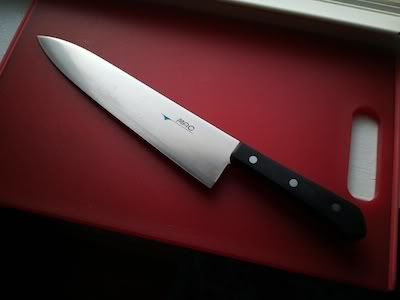
More kitchen knife reviews:
Miyabi Artisan 8″ gyuto/chef’s
Miyabi Fusion petty/utility
Miyabi Fusion 8″ gyuto/chef’s
Blade: approx 142mm (5.5 inches) long; “damascus” warikomi cladding CMV60 (VG-10) core (target 60 HRC); double-bevel edge
Handle: western-style; micarta
Weight: 77g
Price: $80 discounted ($110 standard)
What month is it? Why it’s Knovember—the cuttiest, choppiest, sliciest month of the year! And unlike those other “special” months (you know, the ones like Remorseuary, Junkly, Suicitember and Sucktober) I actually plan to enjoy this one! And how do we celebrate Knovember? Why, naturally it’s by getting, using and talking about knives! Of course that’s a lucky thing for both you and me, reader, since it’s pretty much one of our favorite topics.
For me, Knovember will start with reviewing the Miyabi Fusion 5.5 inch utility knife (initially found during my petty search described here). Granted, I purchased this knife back in October but since I’m talking about it now, it still counts toward the Knovember celebration. 😉
As was the case with my Miyabi Fusion gyuto, the packaging was pretty simple while fit and finish were very good. There is a tiny bit of unevenness noticeable in the butt-end (ha—butt!) of the handle where the spacers and scales meet, but it isn’t super obvious and since that portion of the handle never gets touched during normal use, it was not much of a point of concern for me. Looks are standard for the Fusion line and nice as far as I’m concerned; the damascus cladding isn’t real damascus, of course, but it looks good and isn’t as in-your-face or chincy looking as other, similar knives (for example the Miyabi Kaizens or Shun Kramers).
As for the blade’s more concrete properties, it’s only 5.5 inches long and weighs in at a relatively light 77 grams. On top of that, it has a very central balance point, just behind the ferrule. These properties combine to make it handle a bit like a long paring knife. The thin blade and relatively flat profile also give it elements of a diminutive slicer. The cutting edge was quite sharp out of the box as far as these things go—easily able to shave hair and slice the majority of things that I put in its way—although it does appear to lose that edge relatively quickly.
But how is the performance? I went through two days of dinner prep for myself and the Gastrognome in which I used this knife exclusively so I could test it on a range of foods. I had no issues julienning bell peppers, halving lemons and limes or mincing shallots and jalapeños. It also did well in trimming chicken breasts. Slicing carrots, celery and sausage (raw) proved doable if a bit more difficult than performing the same task with a chef’s knife. Mincing herbs was a pain due to the blade’s lack of rocking ability. A big, brown onion turned out to be the little knife’s downfall; the burly bulb was simply too thick and too broad to be easily diced and I had to cut it into smaller, more manageable pieces before proceeding with a task that would have been no problem at all for a chef’s knife. On the other hand, the small, slender blade did excel in a few areas where a chef’s knife or larger slicer normally doesn’t, namely paring tasks. Peeling an apple, coring a small chili and paring cauliflower florets were all easy as can be and I actually feel like the long, thin tip of this knife even made the latter two tasks simpler than doing them with a regular, squatter paring knife would have been.
Overall I’m really enjoying this knife so far and would definitely recommend it to others looking for something that fits into the realm of “small slicer/large paring knife.” The Gastrognome also likes it and reports that it feels comfortable in her hand and is a nice length for someone with smaller hands as well. If you dig something short and slender, I think this knife is certainly one to consider. For something more utilitarian, however, I would look elsewhere—it may have “utility” in the name, but it isn’t really all-purpose. I’ll also add that I was able to buy this knife at a considerable discount and I think that due to the narrower range of uses one is likely to whip it out for, the standard price does potentially push the cost-to-value ratio into unfavorable territory.
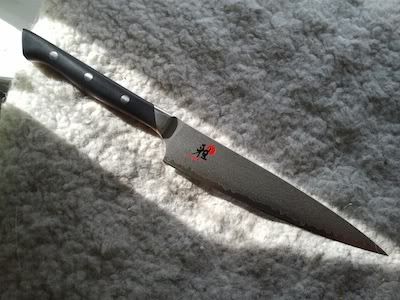
More pics to follow once the friggen sun comes out again.
More kitchen knife reviews:
Miyabi Artisan 8″ gyuto/chef’s
MAC 10″ gyuto/chef’s
Miyabi Fusion 8″ gyuto/chef’s
It’s amazing what you can do when you get real ingredients.
As my earlier tweet decreed, I spent a lovely lunch at the West Side Market of Cleveland, probably the best place to procure fruit, veg, and meat-stuffs anywhere in the city and suburbs. An hour later, I retreated to work arms full with leeks, rainbow chard, carrots, celery, brussels sprouts (my favorite vegetable of all time), two pounds of (Ohio!) ground lamb, and approximately two pounds of assorted fresh pasta and sauce from Ohio City Pasta. This pasta included (most importantly for tonight) rosemary linguini, jalapeño linguini, whole wheat spaghetti, and soba (dear god fresh!).
Around peckish-o-clock, I determined that there was but one course of action for the evening: quick lamb ragout with shaved brussles sprouts, wilted rainbow chard, and leeks over rosemary linguini.
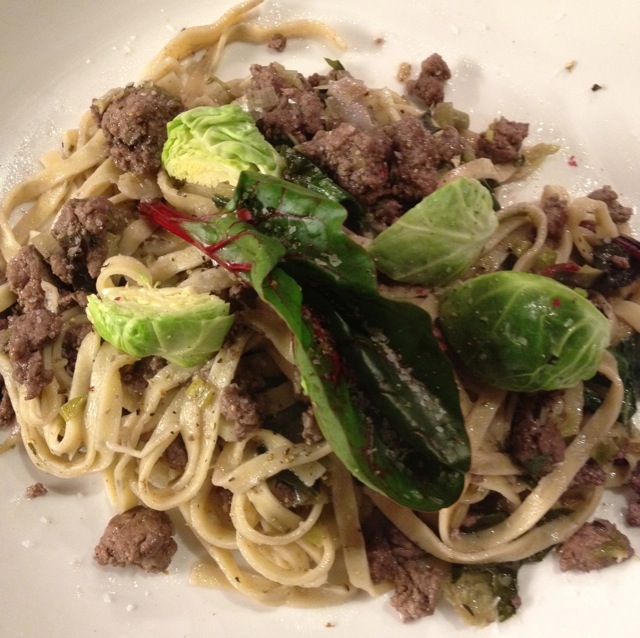 An autumn bounty, even if I hate autumn. Result! Although it was absolutely screaming for a salty, pungent shaving of Pecorino or Parmigiano.
I may or may not have had an epiphany in that I really, REALLY love the west coast.
Now, I knew this before, but after spending two weeks total bouncing from San Francisco (CA), to Bodega Bay (CA), into Napa (CA), over to Sonoma (CA), into Healdsburg, multiple dinners in Sebastapol (CA), then up to Seattle (WA…oh right, you know that one)… I kinda am, well, lost back here in the Land of Cleve. As good as we do here (by food), it’s a real rough return (by everything else).
I am about to make a very bold claim: the west coast lives and eats better than anyone else in the United States.
Whoa, whoa. Hear me out before you call me a complete asshole.
I shall regale you with an epic to rival The Oddyssey [sic] that was the last two weeks of my life/vacation.
…
Yea, ’twere the final fortnight of the Tober of Oct.
The prior two months, little had I eaten and much had I trained to impress the natives of the Left Coast, for others returning from their adventures would exclaim how they, “wish they all could be California girls.” Perhaps, if the gods smiled upon me, I should meet one too.
Weeks it felt like sailing in Iron Eagle (with an hour layover in O’Hare).
Finally I arrived in Francisco’s San. A quaint village with proper transportation, and no shortage of drink and merriment, where I suddenly understood the parable of the ladies, for one took me in said, “I too have similar origins in the East, where the ice ages. Here we have no such troubles. Come, leave your worries at my door.” Clearly, I had no choice, and was enchanted by her, and the 60-degree temperature (free room and board didn’t hurt either). It looked a might foggy, and dangerous, but I had no where else to go.
 Francisco's San That evening we all celebrated with copious amounts of ale and wine.
 Where the Wild Vines Are The fine lass set me up with more than adequate accommodations, but alas, I had a BART to catch in the morning, and could not stay.
I moved on through the port of SFO to meet with my travel companions who took a different ship out, as I found alternate transportation to accommodate my later plans to head farther north. We joyously met up and celebrated our fortunes to unite in such a beautiful place.
 It's an extravaganza (identities masked to protect the innocent)! We then settled in to a local pub for a home-cooked meal. One of local ingredients, local flair, and local charity.
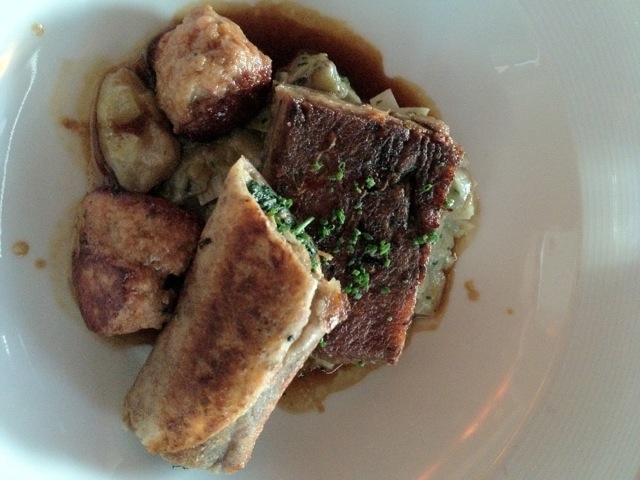 Duck Confit with spinach crêpe, foie gras "meatballs" Served was a local delicacy, one of which I only understood as poisonous. What they had done, in fact, was weave the dastardly stinging nettle into an incredible pasta, both verdant and firm, whilst liberating it from its malevolence.
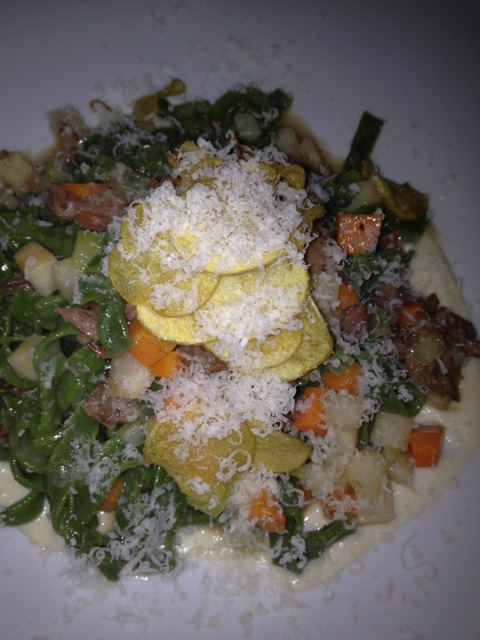 Nettle Pasta with Celery Root Purée We rested easy that eve.
But a few hours later I found myself in the Bay of Bodega: a place famed for it’s agressive waterfowl. I ran not into these accursed avians, and found it nothing but an extremely pleasant place to relax.
 I assume that must be the flag of Scotland Fortunes soon turned, and we were encased in a Witch’s Brew of fog and evil. Yet the beauty of the surroundings was still not lost. It seemed almost inviting, but was sure to remind you to check your step twice.
 A brew most foul? Not to be dissuaded, we set out for another local pub, for it would surely cure our trepidation of the fog.
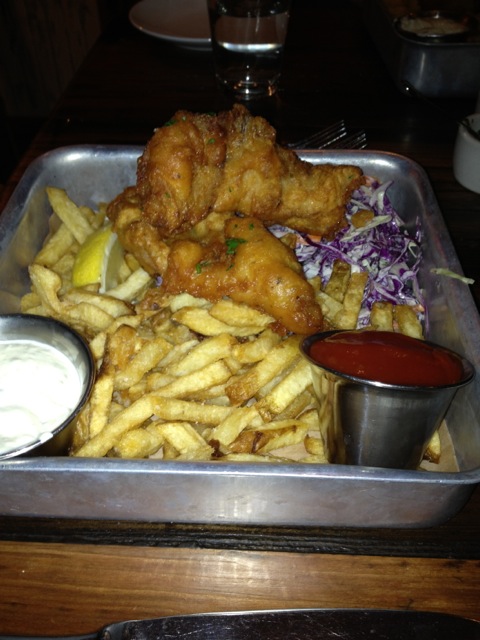 Cod and chips! And ale! Joy! Indeed, the locals came through again, with ale, fish, chips and a myriad of jesters playing jaunty tunes from the other side of the room. Yet again, we were taken aback and thankful in that those who journeyed before would be so generous to those who relive the journey now.
…
Alas, I must rest now dear readers, but soon shall we resume, for not yet have we battled boar, casks of wine, nor seas of reckless abandon.
Stay tuned for part two!
Cutting citrus fruit, trimming meats, mincing garlic, any of those little tasks where a slice or two will suffice and then you don’t need your knife anymore—there are those times when I don’t always feel like a chef’s knife is the best tool for the moment. These thoughts recently combined with my growing dislike for my old, Target-bought santoku and the knowledge that I feel great amounts of joy when purchasing a new knife to cause me to seek out information on petty knives (often referred to as utility knives ’round these parts) that are readily available (and some that are not, but they will have to form the subject of another post at some later point in time). So, when earlier this week I noticed that there was a certain amount of extra time between performing Task A (go to bank) and Task B (go to grocery store) and that Sur La Table and Williams-Sonoma were relatively close to where I could go to accomplish Task A, I decided some investigation was in order. As an experiment, I had myself a look at a variety of knife offerings in the approximately 6-inch, generally under $130 range. The following are my completely subjective, grossly opinionated findings.
The Good:
Zwilling Kramer chef’s knife in 52100:
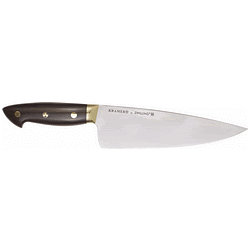
Okay, okay, it’s not a petty and it’s waaaaaaaay beyond the target price range that I set out to explore, but I tried it out anyway, and I have to say it was pretty durn cool. It was very light in spite of the broad look, had a fully rounded spine and choil, and a strikingly thin blade. I chopped up a bunch of zucchini and cabbage with it, which didn’t leave me much space on the cutting board to try out the knives that I had actually come intending to try, but I guess that’s okay, since one should be able to maneuver a petty when there’s limited space… or something. Anyhow, it was fun turning the chopped vegetable bits into ever smaller chopped vegetable bits with this thing in between trying the other knives out. I would also highly recommend taking a look at this line of knives at SLT if you’re in the market for a higher end piece of cutlery that’s still readily available enough to be tested out in person rather than simply being ordered online.
Shun Classic utility:
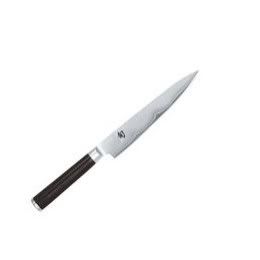
I felt like this knife was good. The price seemed a bit high, and I’m not a big fan of the D handles that Shun uses (this one in particular was a bit too tall and wide compared to the blade for my taste), but overall it was good. It didn’t have that YES! factor to it, but it was certainly more pleasant that not, which is substantially better than I can say for a lot of the other things I tried out. I’m sure that a lot of people would be more than happy to have a knife like this at their disposal.
The Bad:
Global “nakiri”: I don’t know what about this knife made it a nakiri instead of the petty that it looked, felt and acted more like (well, the label, I guess), but regardless of that, it was mostly just a reminder that I like neither the way Globals look nor how they do their handles. I know that some people really like the all-steel tapered handle thing that Globals have going on, but I am not one of them.
Wüsthof Classic utility:

They didn’t have an Ikon to test out, so I poked a few things with the old-skool model instead. There was a time when I thought it would have been great, but my standards have risen since then. The large bolster and heavy weight, in particular, were unappealing for a smaller petty; they impart a feeling of mundane serviceability rather than speed and precision.
Miyabi Kaizen utility:
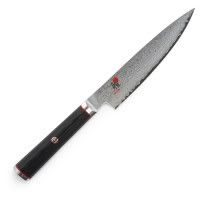
I’m a fan of my Miyabi Fusion gyuto, and when the sales associate assisting me heard that, she was quick to assure me that the new Kaizen line by Miyabi was pretty much an “upgrade in every way” and went on to support this claim with such direct-from-the-sales-blurb-on-the-website points as there being more layers in the cladding and the handles being made of nicer material. I was skeptical of the actual upgradiness compared to the Fusion line, since one of the things I really like about the Fusion knife I already own is the western handle and the Kaizen was sporting an obvious D handle. The Kaizens also appeared to have more belly than the Fusions, in spite of the associate’s insistence that the blade shape was “pretty much the same.”
A brief cutting test proved my doubts–the Kaizen basically took the element I didn’t like from the Shun (too-wide D handle) and compounded it by feeling weightier overall and being extremely blade-heavy. My suspicion that the blade also had more (significantly more, as it turns out) belly than its Fusion cousin was also confirmed. I’m not inherently anti-belly, but I don’t see much point in a knife that has a ton of curve in a blade that’s too short to really rock with. Cutting with this thing was an odd experiment in sensing that the knife clearly had a keen edge that was being kept from performing at the level it could by the other properties of the knife.
Kyocera ceramic utility:
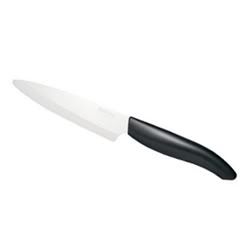
If the Wüsthoff and Kaizen were too overweight, this thing was anorexic. It also looked like a toy. And while the blade was indeed extremely sharp (as expected from a ceramic knife), I couldn’t help but feel like I was standing around cutting stuff with a very pointy credit card. Not my cup of tea.
The Ugly:
Shun “serrated” knife-paddle-thing:
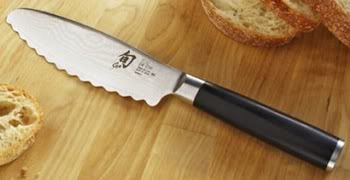
It’s like someone flattened a ladle and put a scalloped edge on one side. If I ever find myself shrunk down to 1/20th of my original size and having to paddle a miniature canoe across a bathtub infested with baby alligators, then maybe I will discover the utility that this thing claims to offer, since I could try to use it to row and fend off uppity reptiles at the same time. Until that happens though, I will have to stick to wondering how somebody out there managed to convince somebody else out there to sell this thing as cutlery.
Shun Ken Onion what the heck?:
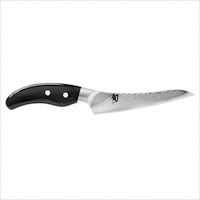
Okay, so unlike the other two entries in this category, this one actually did have some positive aspects, namely a decent cutting edge and a handle that made using a pinch grip relatively comfortable. That said, the handle also more or less prevented one from using any other type of grip, not to mention it’s just plain hideous. Also, the blade was way too curved and using the tip felt awkward because of how you have to hold the knife (you have to really angle your wrist down to do tip-work). The fact that it was also the most expensive of the blades I looked at did not help its cause. I know that there are people out there who like the Shun Ken Onion knives, but I can now say that I’m definitely not one of them.
Zwilling One giant failure:
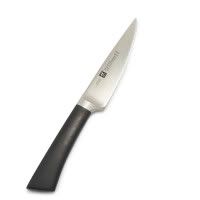
The people at Zwilling JA Henckles clearly know how to do things right at the higher end of the spectrum (like that 52100 Kramer, for example). They’ve also got tons of lines to fill the needs of people who just want cheap or mid-level knives. The Zwilling One is therefore baffling to me because it’s way too expensive to be a cheapo-knife and it’s way too crap to be a decent knife. This thing is far too heavy for its size, the blade has too much belly to be a good slicer but not enough length to be a rocker, and the back of the handle curves downward awkwardly, preventing you from being able to bring the full length of the unnecessarily curved blade to bear on what needs cutting. And yes, as is fitting for this category, it’s also stupid looking.
The Winner:
Miyabi Fusion utility:
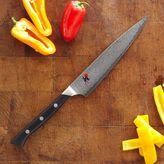
Sporting a profile that was significantly flatter and more slender than a lot of the competition along with good balance and light weight, this knife felt more like an extension of my hand than any of the others. I felt it was conceived of more as a small slicer than an all-purpose knife and as a result I think it really lends itself more to filling that niche of being good at dealing with “things I want to cut but don’t want to bust out a chef’s knife/gyuto for” than the competition. The biggest downside to this knife was the shorter blade length compared to most of the other offerings (only 5 1/2” rather than 6”+). In this respect it kind of dabbles in “long paring knife” territory, although I was able to overlook this with the thought that it leaves me justification for buying a longer petty in the future.
Overall the experiment left two main impressions on me. First is that there are relatively few readily available options for knives in this sort of size and price range, especially compared to other knife varieties. (And yes, if you search online you will find a lot more but if you actually want to test the stuff out in person before you buy it, your choices narrow down very quickly.) Second, the variation in the knives from one brand to another and even one line of knives to another within the same brand was surprisingly high. If you’re looking for a knife like this, I highly recommend trying several out to see what sort of blade suits you the best because there really is a large degree of variation and what works incredibly well for one person may not work at all for the next!
Disclaimer: In no way do I claim to have experience, nor even aptitude, for using heat and ingredients to effect a comestible (refer to my brief bio on this site). Proceed at your own risk.
Despite my growing collection of cookbooks, including a drink mix guide I picked up at an estate sale for only a dollar, I really don’t cook often, much less from one of the tomes. Mostly, I look at the pretty pictures, and question whether or not I could lay my hands on some of the more remote ingredients, like sumac, or, umm, most of the ingredients in my Japanese cookbooks.
So imagine my surprise when I found myself in front of the stove earlier this evening, making a reduction! No cookbook, no Recipe dot com, no memory of even watching a video of a reduction, or even ever tasting a reduction.
Look Ma – no hands!
I’ve become emboldened (and challenged) by my fellow E-Ho’s to just jump into the fray, consequences be damned, and get over my perfectionist butt. So what if it turns out weird? So what if no one tops crinkle cut fries with a reduction? If it tastes good, then it must BE good.
I had decided to make tilapia and fries for dinner for myself and my mom, and it was a very last minute decision. I was going to bake the fish, but at the very last minute was seized with a longing for something fried. I had already decided to bake the fries so they would be softer for my mom to chew, so a fish fry it ’twas.
As I assembled the ingredients and popped the fries into the oven to bake, I remembered going to The Wine Bar with Falquan, about a hundred years ago, and sharing a delicious plate of their “Wino Fries”. I also remembered a recent visit to Claddagh’s and dousing large plank fries with malt vinegar. I then looked over at a bowl of tiny teardrop shaped yellow tomatoes I picked up from Tucker’s Farm just down the street a few days ago, and my brain began to whirl…
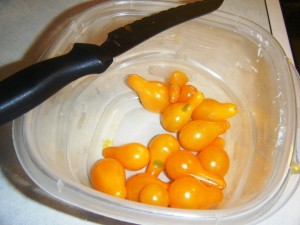 What if I smooshed up these delectable low-acid tomatoes 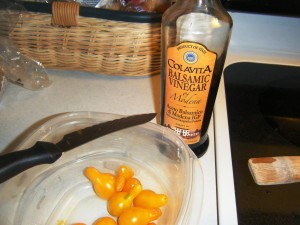 ...and added some balsamic vinegar
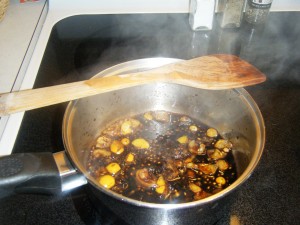 ...and, like, cooked it?
Apparently when one does that, one gets a reduction. REDUCTO!
 This is actually how I reduced my sauce Whilst my spellwork was running in the background, I had fish to fry. Some lovely multi-colored organic eggs to coat the filets was in order
 Let's use the celadon colored one, shall we? Followed by a generous coating of bread crumbs, cornmeal, and French’s Fried Onions
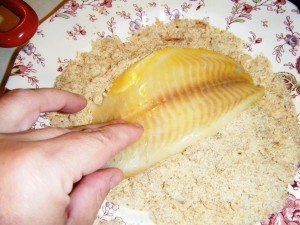 Naked fishy needs a coat And into a cast iron skillet filled with sizzling hot oil. I didn’t use a thermometer, and I’ve never tried to fry anything in this skillet. Just went with my vestigial instinct on this one.
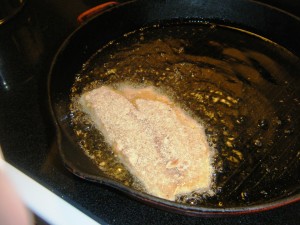 First one in wins the prize! You know, those tilapia fillets are small. I’m just gonna go ahead and cook all six, in two batches.
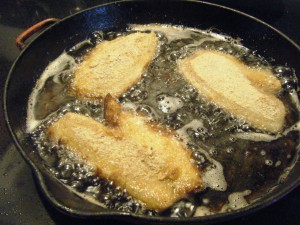 Ouch. I was splattered. Oh well, battle scar.
 Obligatory kitchen gadget plug. Didn't need the spider for this shallow pan, so went back to the tongs. Finally all the little fishies in the kitchen were fried up and waiting to be devoured
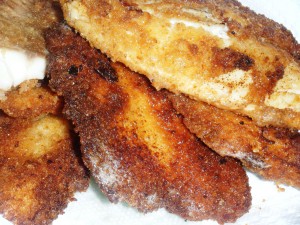 Still sizzlin' after all these seconds
Wow. I’ve never fried fish so well before in my life. I’ll never use anything other than a cast iron skillet again, cross my heart! (Didn’t take pics of me pulling pieces off and shoving them in my maw before I even plated it up, lol.)
……oh, yeah, I haz a reduktion. Let me show you it now, on mah fries.
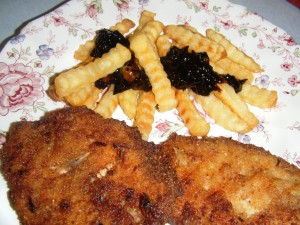 Reduction in place, eating commencing
I’d love to tell you I prepared a delicious cucumber and tomato salad as a side to this fry fest, but it ‘twould taste of a lie.
I ate five of six fillets.
…and it was good.
I’ve wanted to try Dim and Den Sum for over a year. To put it lightly, they’re famous around here in the Land of Cleve. They’re one of the first food trucks to show up around the midwest. And while all you west-coasters will be rolling your eyes, we take a little longer around here to catch on to a good thing.
For those of you not indoctrinated into food truck culture, these roving “restaurants” set up shop at different street corners and office buildings every day or so, then release the details on their websites, Twitters, or FriendFaces/Facebooks on where to find them. Often they’re considered to provide a true taste of what goes on in the region, be it tacos, burritos, stir-fries, or massive sandwiches.
Last Friday, I checked up on their location before heading off to lunch. Right next to the farmer’s market (wait, when did we get a farmers market in downtown?).
I’ll let their website speak for itself on their style and menu, but it’s right up my alley: Asian-American-comfort fusion. I’ve heard for a long time that their food was pretty amazing, and not just for meals on wheels.
I wasn’t ready for something quite this exquisite:
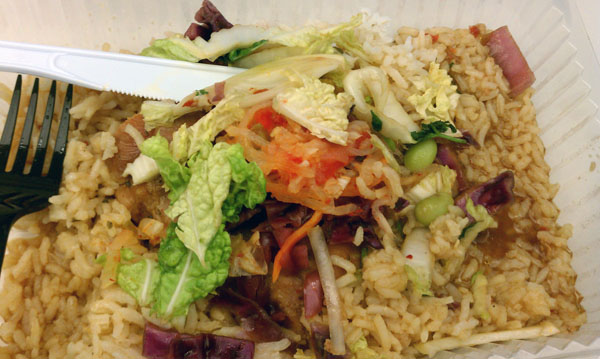 Pao right in the kisser! This, dear readers, is the Dim and Den Sum Kung Pao Chicken with edamame, fried rice, asian slaw and kimchi. From the back of a panel van. In Public Square. Cleveland. Ohio. It looked so good I forgot to take the picture before I began shoving it into my grateful gaping maw.
Mind you, if I wasn’t attempting to retain my girlish figure, I would have obviously gone for the PBLT; pulled pork, bacon, lettuce and tomato sandwich with srirachi aioli. But again, it’s summer and I go on vacation in a couple months.
Seriously, this was incredible as I said, not just from a truck, but as high-end food. I admit, it could have used slightly stronger asian flavors (I like that sort of thing), but it was leaps and bounds over the stereotypical bourbon chicken and fried rice from that joint down the street.
It’s a shame most of us are afraid of these thanks to stories from the previous generation such as “Ptomaine Tom’s Barf Wagon,” apparently (I’m told) a legend around the Ohio State campus circa the late 1960s for having less-than-stellar-food-that-was-amazing-when-drunk-and-possibly-probably-stoned.
Apparently there’s a fleet of food trucks abound north-east Ohio these days; see Walnut Wednesday, and the more enlightened of my co-workers have been dually impressed with the quality and variety of food available right around the corner, being sold out the back of something once reserved for questionable stereo parts.
Keep your stereo parts, I’ve got an iPod. Got any fois gras?
…and not least because of food fests like only the Saarland can deliver.
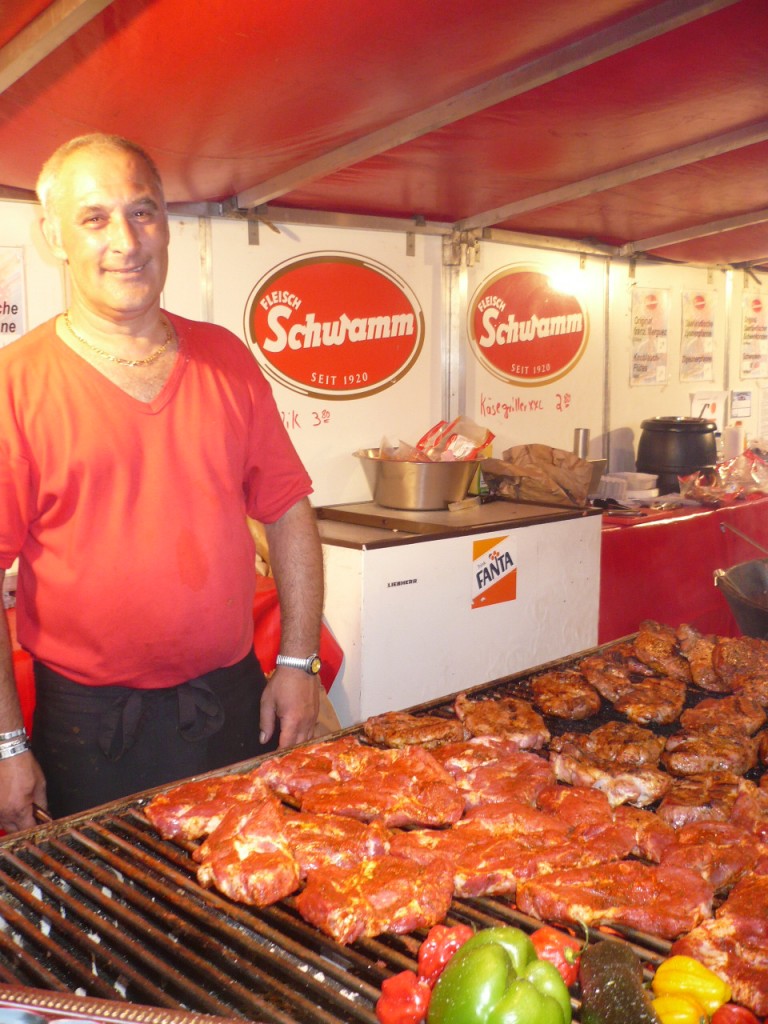 And THIS is why festivals in the Saarland rock.
But I think I forgot the safety word.
I stopped in my local Penzey’s Spices today to restock on a few of my favorite things. Namely the Szechuan Peppercorn Salt, but walked out with a few more things I use all the time: chipotle powder and ancho powder.
I absolutely love this store. They procure extremely high quality spices and expertly vend and blend them. Way cheaper than I can get from my local mega-grocer. You’ll never, ever go back to the McCormicks and Spice Islands. They taste bland, dead and well, old compared to Penzey’s.
Aside from the fineries, what they included in my bag today made me smile:
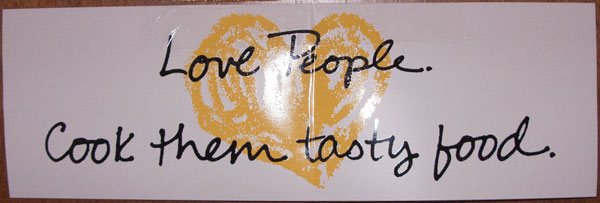 Aww. Although it said on the back it wouldn’t hurt my car’s paint, I love my car, and thus won’t be including on my ass-end anytime soon. But I do think it speaks volumes on the powers of lunch. Therefore it hangs on my kitchen door.
I begin with the onion, as it is the staple in almost every dish conceived in the two millennia. Also, in my past there exists an incident in that a friend was completely unable to choose a quality onion from the grocery store stock, a feat which is by no means difficult, and thus left me aghast. Sure, there’s nothing really sexy about an onion, but, it’s integral to cuisine, and oft overlooked as but a background player.
We begin our journey by attempting to skip the bits already covered by Wikipedia on the subject. If you enjoy such nerdery (and I do), please feel free to detour and return when you’ve had your fill of phyla, species, and other words utilizing more letters than are in the English alphabet. Then I shall grant onto you the details with regard to selecting said foodstuff.
There are generally two types of onions, bulb onions – the spherical, tear-inducing beast with which most of us are partially familiar with, and green onions, the fresh young tender onion oft sprinkled on your Miso soup (or Kung Pao Chicken). There’s a lot of them. From different places. In different colors. But here’s how I break them down:
| Type |
Characteristics |
Names |
Usages |
Sweet Onions
(bulb) |
Mild in flavor
High in sugar
High water content |
Vidalia
Walla Walla
Maui |
Raw
Anywhere an onion is needed |
Cooking Onions
(bulb) |
Strong in flavor
High sulfur content
More tears |
Yellow
Red
Spanish |
Long cooking methods:
Soups and stews
Caramelized Onions |
Green Onions
(not bulb) |
Very mild in flavor
Green tops still attached
Narrow bottom |
Scallions
Green Onions |
Raw (just clean and eat)
Garnish
Quick sauté |
Shallots
(bulb, but technically not an onion) |
Reddish-brown
Garlic-like |
Shallot |
Anywhere mild onion and garlic flavor is desired |
If you couldn’t tell, I’m a personal fan of sweet onions. They provide a background, unidentifiable sweetness to the dish along with the essential onioniness expected. But, green onions are surprisingly good in a crudités platter, or enjoyed quickly grilled with romesco and copious amounts of red wine.
But you’re not here, dear reader, to listen to me wax idiotic about my favorite onion. No, you want to know how to get a good onion.
First and foremost, choose your breed: bulb or green. Let’s start with bulb.

The bulb should be firm. Softball firm. No soft spots/bruises. Softer onions have probably been sitting around for a little longer than you’d like (although, they do keep a surprisingly long time in a cool, dry place). The firm texture above all I have found to be the best indicator of freshness. I prefer to have the paper in-tact on the outside; it’s a pain to remove and deal with, but a nice siding of onion paper shows the onion probably hasn’t been too abused. This goes for shallots as well.
Sweet onion paper may be a little more funky and thinner, so just go by the firmness factor.

Per their name, green onions should be treated much like greens. Look for tops that are vibrant green and crisp. Wilty bits imply that the onion has been around a while (like most things wilty) and green onions do not keep; use within a week. Also, since you’ll want to use the green bits, you’ll want them to look good.
I’ll leave the preparation instructions up to my favorite knife skills video.
Selecting a good onion is incredibly simple; the difficult bit is selecting from the huge amounts of varieties of onions. The best news is that you can treat an onion you don’t know by the way it looks. If it’s bulbous, treat it as a bulb type onion. Does it look like a green onion? Treat it the same – just with larger breeds (leeks), be sure to cut them up then wash; larger onions tend to get a lot of dirt in their leaves.
|
|





































Recent Comments